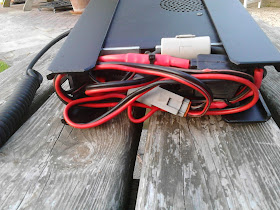 |
| Heard list last weekend |
Are you all very curious how my FSQ activation last weekend went? Well, I was not on the keyboard/radio much but at least my station was open for tests en experiments. Unfortenately we had a lot of QRM from a RTTY contest and sometimes the frequency was very much occupied causing the squelch not to open. I had the idea there is more activity on 40m FSQ compared to the 30m band but it could be the announcement and blogposts from Julian OH8STN and me helped. At daylight most stations are on 7044 for "local" contacts and at night most QSY to 7104 for any DX possebilities. I did the same but didn't see any DX. I saw Richard G3CWI did some tests to retrieve my webcam image. He did receive something but it was not that good (my webcam is not that good, it's just for test purposes). I discovered that if you leave the webcam window open the software (FSQcall) will give a message and your TX will lock. Most of the time I was "on-air" I was on remote with my phone and I was not at home. FSQ is, just like other digimode programs, ideal for remote operation. So far it still is a interesting program and there are enough possebilities you can experiment with to keep you busy for a long time. From HB9AVK I understood there is a way to store messages for the opposite station, I saw him trying but could not find where message has been stored. It would be similair to packet radio and in some way ideal if you can read messages when you attend your radio shack or computer (by remote) but you would need a simple way to retrieve them. I also saw some differences between FSQcall and FLdigi in the station heard list were FLdigi gives a list with reports which is much more interesting. So, I decided to setup my second (portable) digimode station to test things and see what program is more useful and interesting for this mode. My portable station was pe4bas/p and my base station was just pe4bas. It gave me useful insights in the differences between FSQcall and FLdigi.
The differences
| FSQcall | FLdigi |
| | |
| Possible to send webcam images direct from webcam | Not possible to send webcam images direct from webcam |
| Possible to start receive images manually | Not possible to start receive images manually |
| Possible to add a message at sounding transmission | Not possible to add message but sends sounding time in monitor |
| Sends station heard list without reports | Sends station heard list inclusing time heard and signal report |
| Sounding transmits between other transmissions | Sounding has no priority and waits till other transmissions are over |
There might be even more differences but these are the ones I discovered so far. It also occured to me that originally FLdigi callsigns are not set in lower case. If you want to work on FSQ with FLdigi please configure "call in lower case" under tab modems -> FSQ.
Then the case why my receive images were not opened automatically at FSQcall when someone started transmission of a image. My tests revealed that you always need to direct your message and also the transmission of your image. That means if you want to send your image to everyone for reviewing you need to do it like this "allcall%" open your picture send screen and send your message. In FLdigi it opens automatically. That way all receiving stations on the channel will automatically receive your picture. Now it puzzles me how to do that when you want to retrieve the webcam image from FSQ at you opposite station as it is a non directed transmission when you get it with for example "pe4bas% w" it just starts transmitting the image and for FLdigi users that is a problem as they cannot start the image receive manually as far as I know.
Well, I hope this is not to chaotic for you all to read. Most of it has come up in my mind yesterday and today. I don't know which program I prefer for FSQ. If you use Linux it is simple, you choose FLdigi. When using Windows you could run both programs at the same time and use what you please.
Just for FSQ beginners. The picture transmission is not synchronised. That means you have to correct your image after you receive it. The program is sensitive and you need to not start other programs when you receive a image. Above in the picture at the left after I received a photo and at the right after correction. The image was send from pe4bas/p (on dummyload) -> pe4bas and signal was about -5dB
Last but not least a picture from FLdigi with FSQ just after I send a webcam picture to "allcall". This time the receive pic screen opened and after correction this was the result, Don't look at the frequency, the radio was not CAT connected. I tested on 10.144.
I will keep an eye on this mode and software as this is worth some more experimenting. What I showed is just part of the possebilities FSQ has. If you read the manual you will discover that it is capable of exchange telemetry and could be connected to all kind of things like for example a weatherstation. These things are beyond me knowledge but interest me. I hope some of the users will try and make FSQ even more interesting.
Richard G3CWI observed some interesting things as well. You can find his research so far on his blog here:
http://www.sotabeams.co.uk/blog/fsq-data-system-tested/




















